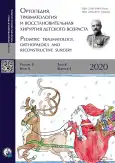Accelerated versus standard Ponseti method for idiopathic congenital talipes equinovarus: a systematic review and meta-analysis
- Authors: Savio S.1, Maharjana M.1,2
-
Affiliations:
- Udayana University
- Sanglah General Hospital
- Issue: Vol 8, No 4 (2020)
- Pages: 473-484
- Section: Review
- URL: https://journal-vniispk.ru/turner/article/view/35161
- DOI: https://doi.org/10.17816/PTORS35161
- ID: 35161
Cite item
Abstract
Background. The standard Ponseti method is a mainstay of treatment for children with congenital talipes equinovarus (CTEV); involving weekly manipulation and long-leg casting, this approach has proven to produce good long-term outcomes. However, it takes approximately 4–5 weeks to correct all deformity components, making compliance a challenge for patients with limited economic resources and difficulty reaching healthcare centres.
Aim. This study aims to compare treatment outcomes between standard Ponseti and an accelerated protocol — applying the same casts but changing them more frequently, every 2-5 days — for the CTEV pathology.
Methods. A systematic search was conducted based on PRISMA guidelines to identify relevant studies through PubMed, Google Scholar, and Cochrane Database. A total of seven studies (324 patients, 408 feet) were included in the meta-analysis. Five outcomes were compared between the two procedures: post-procedure Pirani score, relapse rate, tenotomy rate, number of casts, and total duration of treatment.
Results. For total duration of treatment, the accelerated Ponseti method was superior to standard Ponseti (24.25 vs. 41.54 days, p < 0.00001). On the other hand, it achieved comparable efficacy as measured by post-procedure Pirani score (1.01 vs. 0.87, p = 0.19). Furthermore, the two procedures were also comparable in terms of the total number of casts needed (4.94 vs. 5.05, p = 0.76), tenotomy rate (73.29% vs. 65.27%, p = 0.07) , and relapse rate (27.72% vs 25.23%, p = 0.56).
Conclusion. Accelerated Ponseti offers similar efficacy and shorter duration of treatment compared to the standard Ponseti technique.
Keywords
Full Text
##article.viewOnOriginalSite##About the authors
Sherly Desnita Savio
Udayana University
Author for correspondence.
Email: sherlydsavio@gmail.com
ORCID iD: 0000-0003-4269-1156
MD, Orthopaedic Resident, Orthopaedics and Traumatology Department, Faculty of Medicine Udayana University, Sanglah General Hospital
Indonesia, BaliMade Agus Maharjana
Udayana University; Sanglah General Hospital
Email: agusmaharjana@yahoo.com
ORCID iD: 0000-0002-3953-2798
MD, Consultant of Orthopaedics and Traumatology Department, Faculty of Medicine Udayana University, Sanglah General Hospital
Indonesia, BaliReferences
- Barik S, Nazeer M, Mani BT. Accelerated Ponseti technique: Efficacy in the management of CTEV. Eur J Orthop Surg Traumatol. 2019;29(4):919-924. https://doi.org/10.1007/s00590-018-2353-1.
- Fletcher C. The neglected clubfoot. Glob J Med Res. 2017;17(1).
- Ajmera A, Solanki M, Rawat S. Comparative study of accelerated Ponseti method versus standard Ponseti method for the treatment of idiopathic clubfoot. Journal of Orthopedics, Traumatology and Rehabilitation. 2018;10(2):116. https://doi.org/10.4103/jotr.jotr_11_18.
- Svehlik M, Floh U, Steinwender G, et al. Ponseti method is superior to surgical treatment in clubfoot — long-term, randomized, prospective trial. Gait Posture. 2017;58:346-351. https://doi.org/10.1016/j.gaitpost.2017.08.010.
- Elgohary HS, Abulsaad M. Traditional and accelerated Ponseti technique: A comparative study. Eur J Orthop Surg Traumatol. 2015;25(5):949-953. https://doi.org/10.1007/s00590-015-1594-5.
- Mageshwaran S, Murali VKB, Devendran R, et al. Evaluation of outcome of correction of clubfoot by conventional Ponseti and accelerated Ponseti. Int J Sci Study. 2016;4(10):199-202.
- Harnett P, Freeman R, Harrison WJ, et al. An accelerated Ponseti versus the standard Ponseti method: A prospective randomised controlled trial. J Bone Joint Surg Br. 2011;93(3):404-408. https://doi.org/10.1302/0301-620X.93B3.24450.
- Sahu B, Rajavelu R, Tudu B. Management of idiopathic congenital talipes equinovarus by standard versus accelerated Ponseti plaster technique: A prospective study. Journal of Orthopedics, Traumatology and Rehabilitation. 2015;8(1):30. https://doi.org/10.4103/0975-7341.183960.
- Ahmed J, Shahid S, Alam W, et al. Outcome of patients suffering from congenital idiopathic club foot : A comparative analysis of using classical versus accelerated Ponseti techniques. J Pak Orthop Assoc. 2019;31(2):44-47.
- Herring JA. Tachdjian’s pediatric orthopaedics : From the Texas Scottish Rite Hospital for Children. Saunders; 2013. 1696 p.
- Alves C, Escalda C, Fernandes P, et al. Ponseti method: Does age at the beginning of treatment make a difference? Clin Orthop Relat Res. 2009;467(5):1271-1277. https://doi.org/10.1007/s11999-008-0698-1.
- Lampasi M, Abati CN, Bettuzzi C, et al. Comparison of Dimeglio and Pirani score in predicting number of casts and need for tenotomy in clubfoot correction using the Ponseti method. Int Orthop. 2018;42(10):2429-2436. https://doi.org/10.1007/s00264-018-3873-3.
- Dyer PJ, Davis N. The role of the Pirani scoring system in the management of club foot by the Ponseti method. J Bone Joint Surg Br. 2006;88(8):1082-1084. https://doi.org/10.1302/0301-620X.88B8.17482.
- Lourenco AF, Morcuende JA. Correction of neglected idiopathic club foot by the Ponseti method. J Bone Joint Surg Br. 2007;89(3):378-381. https://doi.org/10.1302/0301-620X.89B3.18313.
- Goriainov V, Judd J, Uglow M. Does the Pirani score predict relapse in clubfoot? J Child Orthop. 2010;4(5):439-444. https://doi.org/10.1007/s11832-010-0287-1.
- Rahman A, Shahiduzzaman M, Alam MK, Rahman MS. Percutaneous needle tenotomy for Ponseti technique in the management of Congenital Talipes Equinovarus (CTEV). Journal of Dhaka Medical College. 2015;23(1):55-59. https://doi.org/10.3329/jdmc.v23i1.22695.
- Cosma DI, Vasilescu DE. Ponseti treatment for clubfoot in Romania: A 9-year single-centre experience. J Pediatr Orthop B. 2014;23(6):512-516. https://doi.org/10.1097/BPB.0000000000000081.
- Dobbs MB, Rudzki JR, Purcell DB, et al. Factors predictive of outcome after use of the Ponseti method for the treatment of idiopathic clubfeet. J Bone Joint Surg Am. 2004;86(1):22-27. https://doi.org/10.2106/00004623-200401000-00005.
Supplementary files















